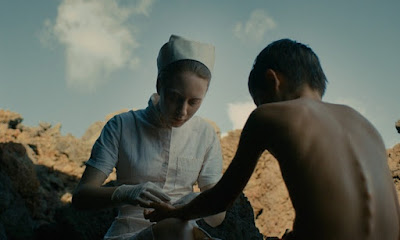 |
| 3000 Nights |
Reviews of the First Feature Competition at London Film Festival
By Kiomars Vejdani
3000 NIGHTS
Director: Mai Masri; Palestine/France/Lebanon/UAE/Qatar, 2015
The film tells the story of a woman who for helping a young man on the run was charged with terrorism and spent eight years in an Israeli prison. Director Mai Masri with her background as a documentary film-maker has created a realistic, textured film with attention to details of environment and characters. Her powerful drama is based on clashes between Israeli and Arab women in the prison (at times amounting to violence), and cruelty inflicted on prisoners by a ruthless wardens (including torture). The horrifying atmosphere of prison well reflects the politically unstable situation in that part of the world where suspicion and hatred are the dominating sentiments.
LAMB
Director: Yared Zeleke; France/Ethiopia/Germany/Norway, 2015
The film is about loving relationship between a small boy and his lamb. The purity of his love is in sharp contrast with harsh attitude of adults who have to deal with realities of life. The boy's love represents innocence of childhood (his minor immoral acts such as petty thefts is carried out in all innocence to save his lamb), but eventually he realizes that a time will come to let his lamb go. Set in unspoiled landscape of Ethiopian mountainside, film tells its story with a simple technique to match the sentiment of is content.
THE WAIT
Director: Piero Messina; Italy, 2015
It is a study in bereavement and loss of loved ones. A mother who has lost her son find herself unable to break the news to her son's girlfriend, waiting for the right moment to do so. The film explores details of woman's grief from denial to acceptance. A suitable vehicle for Julitte Binoche who is expert in portraying women tormented by their emotions.
THE WITCH
Director: Robert Eggers; USA/Canada, 2015
In 17th century New England a devout Christian family living in a farm at the edge of the forest experience strange phenomena which they suspect is due to supernatural powers and work of devil. As the film progresses they gradually begin to suspect their teenage daughter to be a witch. The film's dramatic tension builds up as clashes between members of the family escalates to the histrionic level (similar to the case of Salem witches) ending in the climax of revelation. The film generates an undercurrent of horror in a Gothic atmosphere conveying the existence of evil force. In the final scene film shows the witch as the embodiment of our subconscious desires. Her victory and celebration conveys defeat of Christian faith in the hands of a more powerful enemy.










